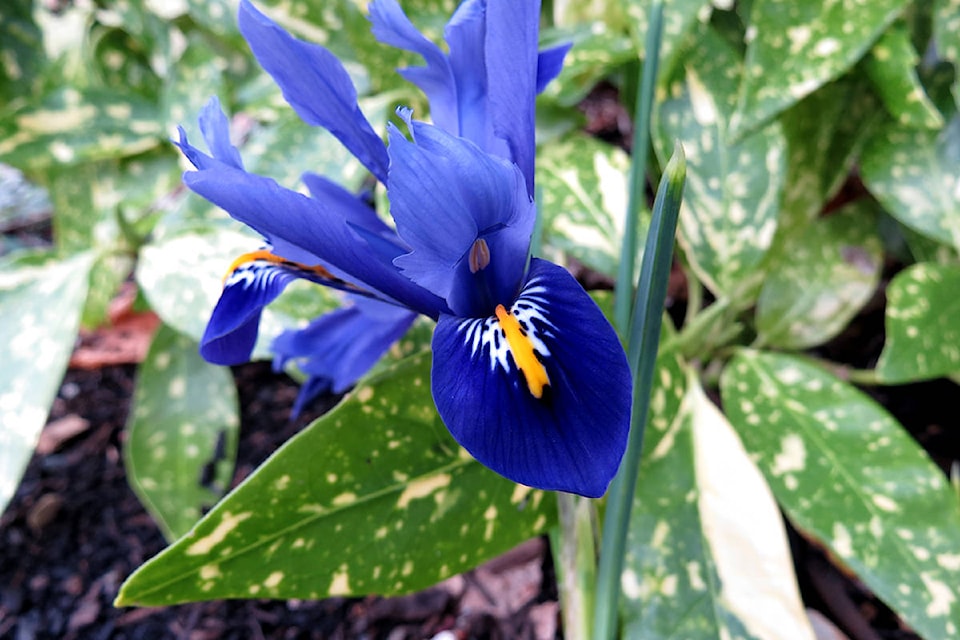LESLIE COX
Special to The Record
It feels good to be working more hours in the garden. Especially since the weather is co-operating in granting us a few degrees above zero. Still, I am glad to have my dad’s thick gardening sweater on. Of course, lots of raking helps to raise the body temperature as well.
I love my spring raking chore. It is preferred to the autumn raking when I have to bury the garden beds in thick leaf mulch for winter insulation. This time of year, I am uncovering everything in the beds… and getting some nice surprises.
All but one of my latest hellebore acquisitions had a short stem of dangling flower buds to show off once the leaf blanket was pulled away. Rather pleased as these were small four-inch pot-size introductions last spring.
I had already been enjoying my older, more established hellebores because their sturdier flower stalks had pushed up above the leaf mulch. The pinky-cream flowers on ‘Ivory Prince’ and dusky-pink ones on ‘Pink Frost’ are a poignant treasure from my mom. She understood my delight in spring blossoms.
As was her own pleasure. Many an early spring visit to my parents in Victoria were spent in driving my mom up and down the cherry and plum blossom-laden, tree-lined streets. Repeatedly. We were not looking in vain for a parking space, just absorbing the beautiful scenery.
Moving on through the garden beds… I spotted tiny stems of Anemone nemorosa ‘Robinsoniana’ (wood anemone) just beginning to appear. Won’t be long before it will be a stunning clump of medium green, deeply-incised leaves topped with masses of star-shaped, lavender-blue flowers.
Not far beyond the wood anemone was the patch of Iris reticulata, a dwarf species native to Eastern Europe. To my mind, the number of thin green stems had grown in number since last spring. A happy thought because I do love the startling blue of the miniature iris flowers, marked with splashes of bright yellow and a bit of white.
Unfortunately, I am not sure if my dwarf iris is more correctly the cultivar called ‘Harmony.’ The problem stems from the variation in published identifying photos ranging from pale blue through deep blue to a pale purple colour.
Did you know the colour blue is rare in nature? It is estimated the number of blue-flowering plants is less than 10 per cent in the plant kingdom. This is because there is no actual blue pigment in plants. Weird, huh?
So how is the colour blue executed in plants? It all hinges on concentrations of different colour pigments, a plant’s molecules and ions, pigment-regulating genes, soil pH, and the plant’s cell structures affecting light reflection.
The human eye is also responsible for the perceived blue colour. We do not all see the same shades of colour in the spectrum which makes colour, like taste, a very personal experience.
All of this is close to explaining why my iris reticulatas are such a deep blue colour with the biggest contributing factor being our low soil pH. The closer to 6.0, and lower, on the pH scale, the more intense the blue coloration.
Helpful garden critters
Moving on in the garden, I have one more discovery to share with you. A young millipede curled up in a tight circle like a coiled rope. A pale pink-cream colour, it looked just like its black mature adult stage. They do good work feeding on decaying plant material but can do some damage to young seedling roots. Possible root damage aside, I leave this guy alone to do the composting for me.
And if you spot its “cousin” the centipede, leave it be too. It is a voracious predator. Both of these can live at least five years.
Leslie Cox co-owns Growing Concern Cottage Garden in Black Creek. Her website is at www.duchessofdirt.ca
